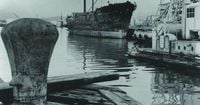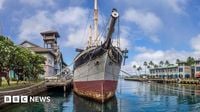In a move that has stirred strong emotions across the maritime world, the historic Falls of Clyde—a Clyde-built sailing ship constructed in Port Glasgow in 1878—was towed out of Honolulu Harbor and deliberately sunk in deep waters off the coast of Hawaii on October 15, 2025. The operation, overseen by the Hawaii Department of Transportation and contractor Shipwright LLC, marked the end of a remarkable 147-year journey for the last surviving iron-hulled, four-masted, fully rigged sailing ship, once a proud symbol of Scotland’s industrial prowess and maritime heritage.
For decades, the Falls of Clyde was a fixture in Honolulu, serving as a floating museum since the 1960s after a storied career that spanned the globe. According to BBC, the vessel was the first in a series of eight iron-hulled ships built by Russell & Co. in the late 19th century. She spent her early years transporting cargo to and from the Far East and Australasia, before being converted in the early 20th century to a tanker carrying paraffin to the Hawaiian islands. Later, she served as a floating fuel depot before her acquisition by a local museum.
But time and the elements were not kind. The Falls of Clyde suffered significant damage during a hurricane in the 1980s, and the subsequent closure of the maritime section of the museum left her exposed to years of neglect and decay. By late 2024, her condition had deteriorated so badly that she was removed from the US National Historic Register, losing the protection and recognition she had held since 1989, as reported by the Ketchikan Daily News.
The Honolulu Harbour Board’s decision to scuttle the ship was driven by both practical and economic considerations. The quay where she had been moored was slated for redevelopment, and the vessel had become a liability, leaking and posing environmental risks. On the morning of October 15, the Falls of Clyde was towed about 25 miles offshore and sunk in deep water—a somber operation that unfolded as the sun rose over the Pacific.
Efforts to save the ship had been ongoing for more than a decade, with campaigners in both Scotland and Hawaii mounting passionate campaigns to return her to her birthplace for restoration. According to STV News, the Friends of Falls of Clyde, a group based in Hawaii, spent years raising awareness and lobbying for the ship’s repatriation. Their efforts included a small send-off ceremony on October 14, the day before the sinking, where bagpipes played in tribute to the ship’s Scottish heritage.
The campaigners’ frustration was palpable. As reported by BBC, the Friends of Falls of Clyde described the day as “a day that will go down in infamy,” adding in a social media post, “It is almost inconceivable that this situation has been allowed to happen.” The Tall Ship Glenlee charity, which cares for another Clyde-built vessel in Glasgow, echoed the sentiment, saying it was “deeply saddened” by the loss.
David O’Neill of the Scotland-based Save Falls of Clyde campaign told the BBC he was “horrified” by the actions of the Hawaiian authorities, though after years of failed negotiations he had come to accept the ship’s likely fate. O’Neill first became involved in 2015, after being alerted to the vessel’s dire condition. He famously posted an appeal on social media: “Old Scottish lady needs a lift home.”
There were moments of hope. According to Glasgow Live, a Norwegian heavy lift company once offered to transport the Falls of Clyde back to Scotland for free, but negotiations with the harbor board over insurance and other conditions fell apart. More recently, an American firm secured a contract to remove the ship and also offered to take her home at no cost, but that deal, too, broke down. The contract ultimately went to another company, which carried out the scuttling.
For those who witnessed her final moments, the experience was both poignant and surreal. O’Neill described seeing video footage of the ship being towed out of the harbor: “She was towed out of harbour looking really elegant and stunning for a 147-year-old ship, unaided, not needing any pumps. She was still afloat and for us that’s representative that she was truly Clydebuilt.” He added, “She goes down by the stern and most of the ship lifts out of the water, like in the Titanic movie.”
Even as the ship slipped beneath the waves, efforts were made to preserve her legacy. The ship’s nameplate, wheel, and bell were salvaged, along with other artifacts, and transferred to the National Park Service for display at the San Francisco Maritime National Historic Park. Some rigging tools from the Falls of Clyde will be used to help maintain the Balclutha, another historic Scottish-built vessel moored at the same park, according to STV News.
The Falls of Clyde’s story is one of both triumph and tragedy—a testament to the ingenuity of 19th-century shipbuilders and the shifting priorities of the modern world. Her loss has reignited debate over the preservation of maritime heritage, especially as historic ships around the globe face mounting challenges from age, weather, and changing economic realities.
“It is a tragedy for maritime history,” said one conservationist, “but perhaps also a wake-up call for all who value these irreplaceable links to our collective past.” For O’Neill and others, the focus now shifts to new projects, such as the potential repatriation of the Type 21 frigate HMS Ambuscade, another Glasgow-built vessel with its own storied past.
While the Falls of Clyde may be gone, the passion she inspired endures—fueling efforts to ensure that the lessons of her long and eventful life are not forgotten. The artifacts saved from her hull will serve as tangible reminders of a ship that once bridged continents and eras, and whose final voyage, though bittersweet, will not be lost to history.

